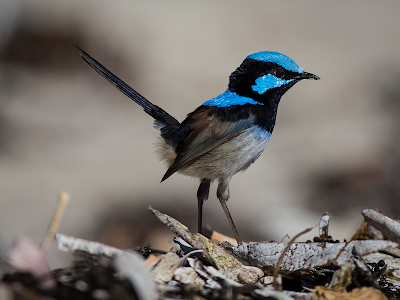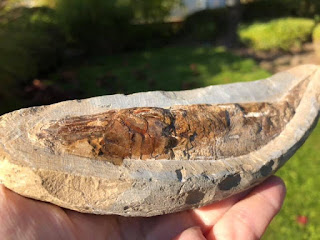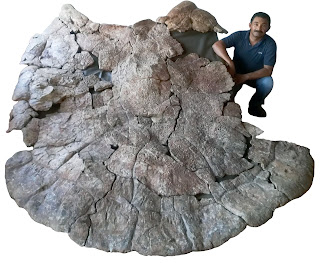This is a tale of how that all began. Back in November 1993, Chinese palaeontologists Hou Lianhai and Hu Yoaming, of the Institute of Vertebrate Paleontology and Paleoanthropology (IVPP) in Beijing received a call from an excited local fossil collector.
He claimed to have quite a remarkable specimen on his hands. The team visited Zhang He at his home in Jinzhou, or Chinchow, a coastal prefecture-level city in central-west Liaoning province
Zhang showed them a spectacular fossil bird specimen he'd recently purchased at a local flea market. Very little was known about the specimen but it was clearly important and the team was hopeful more of this paleo goodness might turn up.
They didn't have that long to wait. A month after his visit to Zhang, Hou learned about a second specimen discovered by a local farmer, Yang Yushan. Things were looking up. Best of all, he learned that both specimens were likely from the same locality in Shangyuan, Beipiao. This was not a one-off discovery or an amazing but anonymous find. With two specimens to compare, the locality determined, the possibility of an interesting publication and career advancement would be a reality.
In 1995, the two specimens, as well as a third, were formally described as a new genus and species, Confuciusornis sanctus, by Hou and colleagues. The generic name combines the philosopher Confucius with a Greek ὄρνις, (ornis), "bird". The specific name means "holy one" in Latin and is a translation of Chinese 圣贤, shèngxián, "sage", again in reference to Confucius.
The first discovered specimen was designated the holotype and catalogued under the specimen number IVPP V10918; it comprises a partial skeleton with skull and parts of the forelimb.
Of the other two skeletons, one (paratype, IVPP V10895) comprises a complete pelvis and hind limb, and the other (paratype, IVPP V10919–10925) a fragmentary hind limb together with six feather impressions attached to both sides of the tibia or shin bone.
All was well until those reading the journal articles realized that the two paratype specimens only comprise bones that were unknown from the holotype. An oversight, likely by design, but this lack of overlap between the specimens made their referral to the species speculative. The lack of overlap also gave a wide margin for error in the naming of additional, albeit hopeful, new species names — names that would later need to be amended. Luckily, the discovery of a veritable treasure trove of well-preserved specimens shortly after confirmed that the specimens indeed represented a single species.
Together with the early mammal Zhangheotherium, which was discovered about the same time, Confuciusornis was considered the most remarkable fossil discovery of the Jehol biota.
It has also given us another fossil-rich Lagerstätte that includes a wonderful mix of advanced and ancient species. My speculation is that northeast Asia was isolated for part of the Jurassic by the Turgai Sea that separated Europe from Asia at that time. The fossils at Jehol are numerous and exceptionally well preserved. Think of the Cambrian goodies at Burgess or the Altmühltal Formation, Jurassic Konservat-Lagerstätte at Solnhofen. Quite remarkably, fully articulated skeletons, soft tissues, colour patterns, stomach contents, and twigs with leaves and flowers still attached, can be found within the Jehol biota.
 |
| A beautifully preserved Archaeopteryx |
Yixian Formation, the rock unit where most Confuciusornis specimens have been found, was thought to be of Late Jurassic (Tithonian) age at the time.
Although two bird genera, Sinornis and Cathayornis, had already described from the Jehol biota back in 1992, these were based on fragmentary remains and stem from the younger Jiufotang Formation. At the time, the Jiufotang was thought to be Early Cretaceous. Both formations have since been dated to the Lower Cretaceous — Barremian to Aptian — 131–120 million years ago.
In 1995, local farmers began digging for fossils near the village of Sihetun, Beipiao, in what would become one of the most productive localities of the Jehol biota. The then largely unknown site is truly world-class. Large-scale professional excavations at this single locality have been carried out by the IVPP from 1997 onwards. Not one, not two, but several hundred specimens of Confuciusornis have now been unearthed from here. Many additional sites producing fossils of the Jehol biota have been recognized since, distributed over a large region including Liaoning, Hebei, and Inner Mongolia.
Due to the great abundance, preservation, and commercial value of the fossils, excavations by local farmers produced an unusually high number of fossils. Although some of these fossils have been added to the collections of Chinese research institutions, more have been smuggled out of the country.
In 1999, it was estimated that the National Geological Museum of China in Beijing housed nearly a hundred (100) specimens of Confuciusornis, and in 2010, the Shandong Tianyu Museum of Nature was reported to possess five hundred and thirty-six (536) specimens. While it is illegal to export them, the majority of specimens are still held privately and thus are not available for research. I see them on social media and occasionally they come up for sale on eBay.
At one time forty individuals were discovered on a surface of about 100 m2. This unusual bone bed was likely the result of an entire flock of birds being simultaneously killed by ash, heat or poisonous gas following the volcanic eruptions that caused the tuff stone in which the fossils were found to be deposited as lake sediments. An avian death bed is highly unusual. Very sad for our feathered friends but grateful for what has been revealed by this rare event.
Notes: Confuciusornis chuonzhous was named by Hou in 1997 based on specimen IVPP V10919, originally a paratype of Confuciusornis sanctus. The specific name refers to Chuanzhou, an ancient name for Beipiao. Confuciusornis chuonzhous is now generally considered synonymous with Confuciusornis sanctus.
Confuciusornis suniae, named by Hou in the same 1997 publication, was based on specimen IVPP V11308. The specific name honours Madam Sun, the wife of Shikuan Liang who donated the fossil to the IVPP. Confuciusornis suniae is now usually considered synonymous with Confuciusornis sanctus.
Reference: Zhou, Z; Hou, L. (1998). "Confuciusornis and the early evolution of birds". Vertebrata PalAsiatica. 36 (2): 136–146.
Zhou, Z. (2006). "Evolutionary radiation of the Jehol Biota: chronological and ecological perspectives". Geological Journal. 41 (3–4): 377–393. doi:10.1002/gj.1045.
































